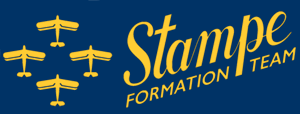
The Stampe

Jean Stampe and Maurice Vertongen met in the Belgian Air Force during the First World War and in 1923, they formed the Stamp and Vertongen (SV) Company at Antwerp. In1933, Jean Stampe flew the first prototype of the SV-4, designed by George's Ivanoff. The Stampe was designed as a trainer and won a contract to supply the Belgian Air Force with 300 aircraft during 1939 follow d by an order from the French Air Force for 600. At the outbreak of World War II, 40 aircraft had been produced in Antwerp and by Farman in France but the only aircraft to survive the war was OO-ATD which was flown by two Belgian pilots to England during 1941.
After the war, the French manufacturing company SNCAN produced 701 SV-4A Stampes powered by the Renault 4P engine at their factory Chatillon sous Bagneux on the river Seine. Jean Stampe with Alfred Renard produced 65 aircraft for the Belgian Air Force, powered by the De havilland Gipsy Major engine, the SV-4 B and C model and 150 aeroplanes were produced in Algeria by Atelier Industrial de L'air. Stampes produced with a Renault engine but later reengineer with a Gipsy Major were known as an SV-4C/G.
The Stampe became a stalwart of aerobatic competitions both in France and the rest of Europe and was much loved for the harmonised, light and effective controls. Although the Stampe differs significantly from the Tiger Moth in having a tail wheel, reasonably effective brakes and an extra set of ailerons to provide increased roll rate the aircraft are still confused by the casual observer but to fly, the aeroplanes are chalk and cheese. Possibly the most well known Stampe airshow act was that of the Rothmans Formation team that operated 4 Stampes during the early 1970s prior to changing to the Pitts Special and the legendary Neil Williams who came 2nd in the final Lockheed Trophy flying an SV-4C, G-ASHS.